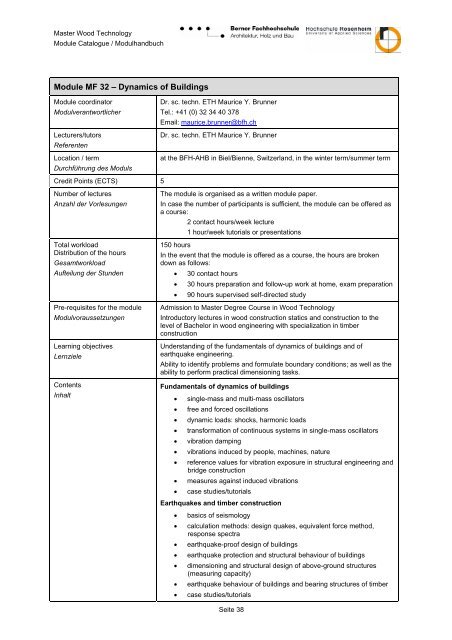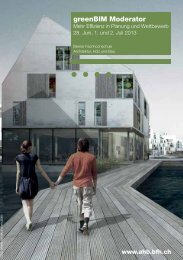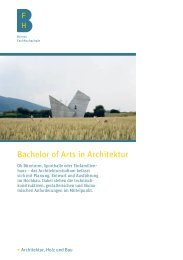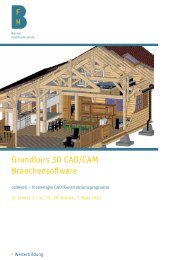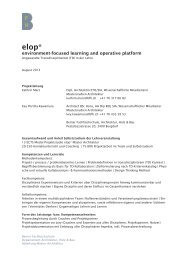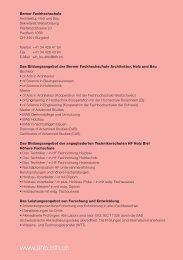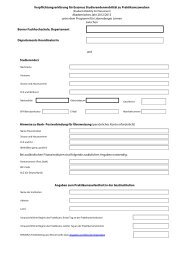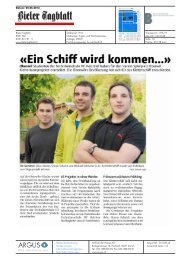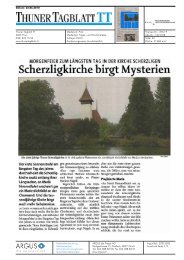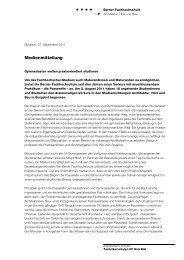M. Eng. Wood Technology / Holztechnik - Hochschule für Architektur ...
M. Eng. Wood Technology / Holztechnik - Hochschule für Architektur ...
M. Eng. Wood Technology / Holztechnik - Hochschule für Architektur ...
You also want an ePaper? Increase the reach of your titles
YUMPU automatically turns print PDFs into web optimized ePapers that Google loves.
Master <strong>Wood</strong> <strong>Technology</strong><br />
Module Catalogue / Modulhandbuch<br />
Module MF 32 – Dynamics of Buildings<br />
Module coordinator<br />
Modulverantwortlicher<br />
Lecturers/tutors<br />
Referenten<br />
Location / term<br />
Durchführung des Moduls<br />
Credit Points (ECTS) 5<br />
Number of lectures<br />
Anzahl der Vorlesungen<br />
Total workload<br />
Distribution of the hours<br />
Gesamtworkload<br />
Aufteilung der Stunden<br />
Pre-requisites for the module<br />
Modulvoraussetzungen<br />
Learning objectives<br />
Lernziele<br />
Contents<br />
Inhalt<br />
Dr. sc. techn. ETH Maurice Y. Brunner<br />
Tel.: +41 (0) 32 34 40 378<br />
Email: maurice.brunner@bfh.ch<br />
Dr. sc. techn. ETH Maurice Y. Brunner<br />
at the BFH-AHB in Biel/Bienne, Switzerland, in the winter term/summer term<br />
The module is organised as a written module paper.<br />
In case the number of participants is sufficient, the module can be offered as<br />
a course:<br />
2 contact hours/week lecture<br />
1 hour/week tutorials or presentations<br />
150 hours<br />
In the event that the module is offered as a course, the hours are broken<br />
down as follows:<br />
� 30 contact hours<br />
� 30 hours preparation and follow-up work at home, exam preparation<br />
� 90 hours supervised self-directed study<br />
Admission to Master Degree Course in <strong>Wood</strong> <strong>Technology</strong><br />
Introductory lectures in wood construction statics and construction to the<br />
level of Bachelor in wood engineering with specialization in timber<br />
construction<br />
Understanding of the fundamentals of dynamics of buildings and of<br />
earthquake engineering.<br />
Ability to identify problems and formulate boundary conditions; as well as the<br />
ability to perform practical dimensioning tasks.<br />
Fundamentals of dynamics of buildings<br />
� single-mass and multi-mass oscillators<br />
� free and forced oscillations<br />
� dynamic loads: shocks, harmonic loads<br />
� transformation of continuous systems in single-mass oscillators<br />
� vibration damping<br />
� vibrations induced by people, machines, nature<br />
� reference values for vibration exposure in structural engineering and<br />
bridge construction<br />
� measures against induced vibrations<br />
� case studies/tutorials<br />
Earthquakes and timber construction<br />
� basics of seismology<br />
� calculation methods: design quakes, equivalent force method,<br />
response spectra<br />
� earthquake-proof design of buildings<br />
� earthquake protection and structural behaviour of buildings<br />
� dimensioning and structural design of above-ground structures<br />
(measuring capacity)<br />
� earthquake behaviour of buildings and bearing structures of timber<br />
� case studies/tutorials<br />
Seite 38


